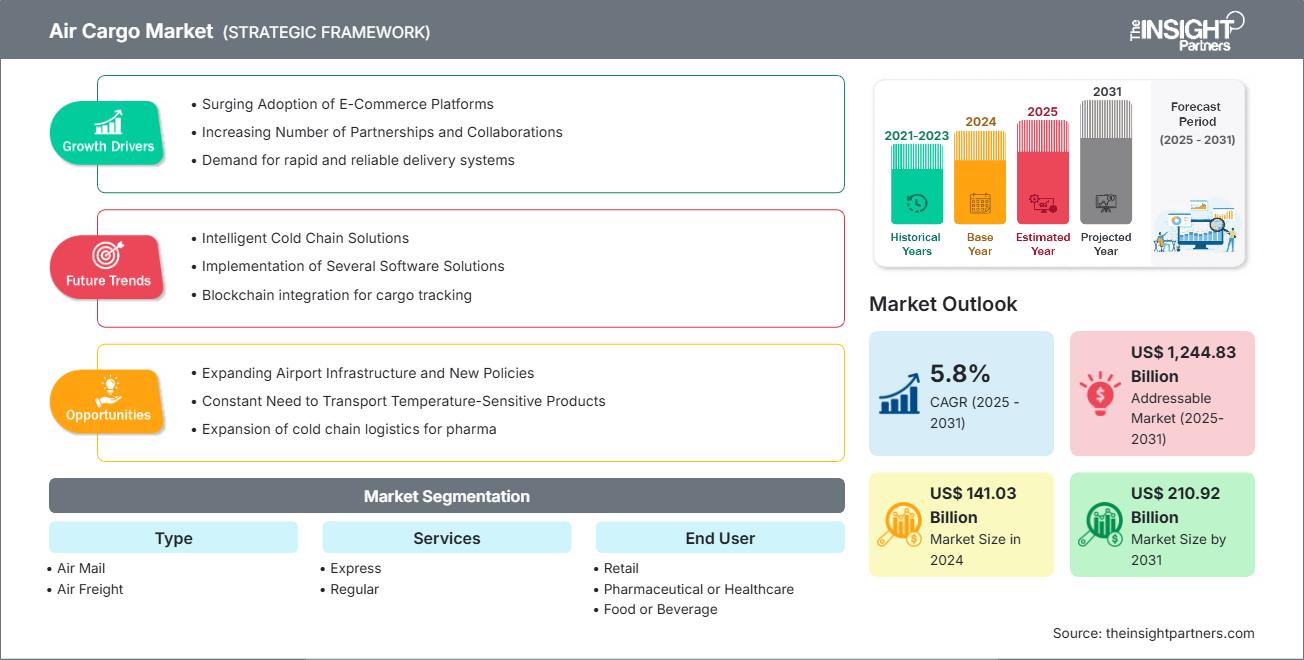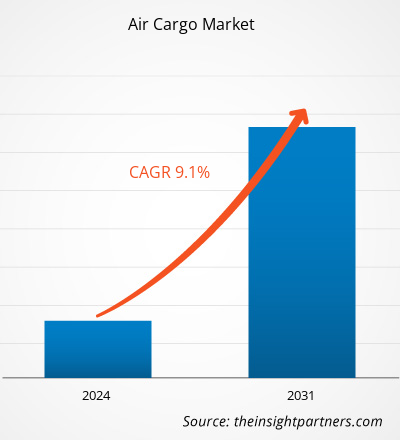预计航空货运市场规模将从 2024 年的 1410.3 亿美元增至 2031 年的 2109.2 亿美元。预计 2025 年至 2031 年期间该市场的复合年增长率为 5.8%。
航空货运市场分析
航空货运市场正在快速增长,这得益于终端用户需求的不断增长,这主要源于消费者偏好的不断变化、技术进步以及对产品优势的认知度不断提升。随着需求的增长,企业正在扩展产品线,不断创新以满足消费者需求,并抓住新兴趋势,从而进一步推动市场增长。
航空货运市场概览
航空货运是一种通过飞机快速运送货物的运输方式。它通过提升向全球消费者运送高价值优质产品的能力,促进经济发展。航空货运行业已取得多项进展。基于低燃料成本和劳动力成本的创新物流和供应链理念已成为准时生产和终端制造装配的关键趋势。此外,随着消费电子产品等新产品保质期的缩短,对快速运输、控制和透明度的需求也随之激增。
您可以免费定制任何报告,包括本报告的部分内容、国家级分析、Excel 数据包,以及为初创企业和大学提供优惠和折扣
航空货运市场:战略洞察

- 获取此报告的顶级关键市场趋势。此免费样品将包括数据分析,从市场趋势到估计和预测。
航空货运市场的驱动力和机遇
市场驱动因素:
电子商务平台的采用率激增:
由于覆盖全球,在线零售比实体店吸引了更多消费者。此外,电商市场参与者选择通过地面运输和空运等物流方式将包裹递送给客户。随着全球电商市场的兴起,人们观察到了各种不同的购买模式和趋势。伙伴关系和合作关系不断增加:
2024年,靛蓝航空货运与法荷航货运及荷兰马丁航空货运签署了一项广泛的联运协议。此次合作旨在提高双方联合网络的配送准确性和效率,扩大靛蓝航空的覆盖范围,并改善印度与欧洲之间的货运服务。
市场机会:
机场基础设施和新政策:
新加坡、泰国和印度尼西亚等东南亚国家,航空货运利益相关者拥有巨大的机遇。东南亚国家的机场是全球发展最快的机场。土耳其货运公司正在通过推出新的货运服务来扩大其影响力。
航空货运市场报告细分分析
为了更详细地了解航空货运市场的运营情况、增长机遇和新兴趋势,我们将航空货运市场划分为多个细分市场。以下是大多数行业报告中使用的标准细分方法:
按类型:
航空邮件:
由于跨境电子商务的加速增长以及对小包裹和文件的快速、可靠递送需求的不断增长,航空邮件行业在 2024 年经历了复苏。空运:
空运是指通过航空公司(可以是商业航空公司或包机)运输货物。随着快速配送需求的不断增长,人们对快递的偏好也日益增长。
按服务:
常规服务:
常规航空货运涵盖一般货运服务,适用于对时间要求不高且体积较大的货物。2024年,该领域将占据全球航空货运市场的最大份额。加急服务:
到2024年,快递航空货运将成为全球航空货运市场中增长最快、最具活力的领域,这得益于电子商务的不断发展、消费者对当日和次日送达的期望不断提高,以及各行业即时供应链模式的日益普及。
按最终用户:
- 制药
- 零售
- 食品和饮料
- 消费电子产品
- 其他的
每个行业对航空货运都有特定的要求,这影响着人们对速度、便利性和可持续性的持续关注。
按地域划分:
- 北美
- 欧洲
- 亚太地区
- 南美洲和中美洲
- 中东和非洲
亚太地区的航空货运市场预计将出现最快的增长。这一增长主要得益于跨境电子商务行业的不断扩张。
航空货运市场区域洞察
Insight Partners 的分析师已详尽阐述了预测期内影响航空货运市场的区域趋势和因素。本节还讨论了北美、欧洲、亚太地区、中东和非洲以及南美和中美洲的航空货运市场细分和地域分布。
航空货运市场报告范围
| 报告属性 | 细节 |
|---|---|
| 2024年的市场规模 | 1410.3亿美元 |
| 2031年的市场规模 | 2109.2亿美元 |
| 全球复合年增长率(2025-2031) | 5.8% |
| 史料 | 2021-2023 |
| 预测期 | 2025-2031 |
| 涵盖的领域 | 按类型
|
| 覆盖地区和国家 | 北美
|
| 市场领导者和主要公司简介 |
|
航空货运市场参与者密度:了解其对业务动态的影响
航空货运市场正在快速增长,这得益于终端用户需求的不断增长,而这些需求的驱动因素包括消费者偏好的不断变化、技术进步以及对产品优势的认知度不断提高。随着需求的增长,企业正在扩展其产品线,不断创新以满足消费者需求,并利用新兴趋势,从而进一步推动市场增长。

- 获取航空货运市场主要参与者概览
航空货运市场份额按地区分析
预计未来几年亚太地区将实现最快的增长。南美、中美、中东和非洲等新兴市场也为航空货运供应商提供了许多尚未开发的扩张机会。
各地区航空货运市场的增长情况各不相同。这主要受电子商务行业的兴起以及各国之间贸易增长等因素的影响。以下是各地区市场份额和趋势的总结:
1. 北美
市场份额:
占据全球市场的很大份额关键驱动因素:
- 电子商务的增长正在推动对快速和灵活运输的需求。
- 高科技和医药出口需要时间敏感的运输。
- 强大的基础设施和主要货运枢纽(例如孟菲斯、安克雷奇)。
趋势:
客运航空公司扩大专用货运机队,以实现收入来源多元化。
2.欧洲
市场份额:
由于欧盟早期的严格法规,占据了相当大的份额关键驱动因素:
- 欧洲内部贸易和制造供应链。
- 对快递和易腐货物物流的需求不断增长。
- 欧盟可持续发展倡议正在推动高效的多式联运物流。
趋势:
采用绿色空运解决方案和SAF(可持续航空燃料)来减少排放。
3. 亚太地区
市场份额:
增长最快、市场份额占主导地位的地区关键驱动因素:
- 来自中国、韩国和日本的大量电子商务出口。
- 强大的制造和半导体供应链依赖性。
- 亚洲、北美和欧洲之间的战略航空货运走廊。
趋势:
跨境电商物流平台和数字货运代理商的兴起。
4.南美洲和中美洲
市场份额:
尽管规模较小,但增长迅速关键驱动因素:
- 出口水果、鲜花、海鲜等易腐烂物品。
- 中产阶级消费的增长正在增加进口需求。
- 对机场和冷链基础设施的投资。
趋势:
转向区域货物整合中心,以改善连通性并降低成本。
5.中东和非洲
市场份额:
市场稳步增长关键驱动因素:
- 作为各大洲间转运枢纽的战略位置。
- 国家航空公司对货运机队的投资(例如阿联酋航空货运公司、卡塔尔航空货运公司)。
- 石油、医疗用品和电子产品是空运量的主要组成部分。
趋势:
在主要机场附近开发综合物流城市和自由贸易区(例如迪拜南站、基加利物流平台)。
航空货运市场参与者密度:了解其对业务动态的影响
市场密度高,竞争激烈
由于联邦快递、UPS航空、DHL航空等老牌航空公司的存在,竞争十分激烈。阿联酋航空(阿联酋)和英国航空(英国)等区域性和利基供应商也加剧了不同地区的竞争格局。
这种激烈的竞争促使公司通过提供以下产品脱颖而出:
- 货运船队投资
- 冷链基础设施投资。
机遇与战略举措
- 实施人工智能、物联网和区块链,实现实时跟踪、路线优化和需求预测。
- 数字货运平台正在重塑货运代理与承运人的关系。
在航空货运市场运营的主要公司有:
- 联邦快递。(美国)
- UPS航空(美国)
- DHL航空。(德国)
- 阿联酋航空货运公司(迪拜)
- 国泰货运航空(中国)
- 大韩航空货运(韩国)
- 汉莎货运(德国)
- 新加坡货运航空(新加坡)
- 中华航空货运。(台湾)
- 英国航空全球货运(英国)
免责声明:以上列出的公司没有按照任何特定顺序排列。
研究过程中分析的其他公司:
- 卡塔尔航空货运
- 土耳其货运
- 阿提哈德货运
- 埃塞俄比亚货运和物流服务
- 沙特货运(Saudia Cargo)
- 韩亚货运
- 法航荷航马丁航空货运
- 空桥货运航空
- MASkargo(马来西亚航空货运)
- 日本货运航空(NCA)
- 丝绸之路西部航空
- 拉美航空货运
- 阿维安卡货运
- 航空学
- 卡利塔航空
航空货运市场新闻和最新发展
SpiceXpress 与班加罗尔 Star Air 合作
SpiceXpress 与总部位于班加罗尔的星空航空 (Star Air) 合作,共同管理星空航空机队的腹舱容量。此次合作为 SpiceXpress 的国内航线网络新增了九个目的地,增强了门到门配送和航空货运基础设施,尤其是在印度服务欠缺的地区。沙特货运签署两项重要全球物流合作协议
沙特航空货运公司签署了两项重要的全球物流合作协议——一项是与丹麦Scan Global Logistics (SGL) 签署的,另一项是与Air Logistics Group 签署的。与SGL的合作使其能够优先使用沙特航空货运公司的全球网络,而与Air Logistics Group的合作则增强了英国和沙特阿拉伯之间的综合航空货运解决方案。
航空货运市场报告范围和交付成果
《航空货运市场规模和预测(2021-2031)》报告对以下领域进行了详细的市场分析:
- 范围内涵盖的所有主要细分市场的全球、区域和国家层面的航空货运市场规模和预测
- 航空货运市场趋势以及市场动态,例如驱动因素、限制因素和关键机遇
- 详细的 PEST 和 SWOT 分析
- 航空货运市场分析涵盖主要市场趋势、全球和区域框架、主要参与者、法规和最新市场发展
- 行业格局和竞争分析,涵盖市场集中度、热图分析、知名参与者以及航空货运市场的最新发展
- 详细的公司简介
- 历史分析(2 年)、基准年、预测(7 年)及复合年增长率
- PEST和SWOT分析
- 市场规模、价值/数量 - 全球、区域、国家
- 行业和竞争格局
- Excel 数据集
近期报告
客户评价
购买理由
- 明智的决策
- 了解市场动态
- 竞争分析
- 客户洞察
- 市场预测
- 风险规避
- 战略规划
- 投资论证
- 识别新兴市场
- 优化营销策略
- 提升运营效率
- 顺应监管趋势




















 获取免费样品 - 航空货运市场
获取免费样品 - 航空货运市场